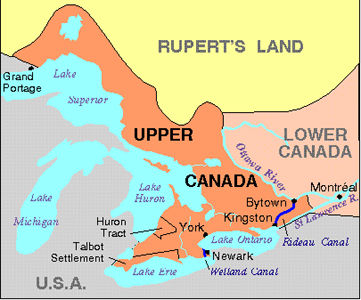Browse "Military"
-
Article
Thomas Talbot
After 1825, Talbot's power began to decline for reasons that included a popular spirit of reform, increasing bureaucracy and Talbot's eccentricity. Socially intolerant and exclusive, he lived alone and isolated in his Pt Talbot "castle.
"https://d2ttikhf7xbzbs.cloudfront.net/media/media/d1817dce-5cf3-4afa-85b7-a8d39574989e.jpg" // resources/views/front/categories/view.blade.php
https://d2ttikhf7xbzbs.cloudfront.net/media/media/d1817dce-5cf3-4afa-85b7-a8d39574989e.jpg
-
Article
Tillson Lever Harrison
Tillson Lever Harrison, physician, surgeon, army officer, adventurer (b at Tillsonburg, Ont 7 January 1881; d near Kaifeng, China, 10 January 1947). Also known as a writer, raconteur and humanitarian, Tillson Harrison has been touted as Canada's second Norman BETHUNE and the model for Indiana Jones.
"https://development.thecanadianencyclopedia.ca/images/tce_placeholder.jpg?v=e9dca980c9bdb3aa11e832e7ea94f5d9" // resources/views/front/categories/view.blade.php
https://development.thecanadianencyclopedia.ca/images/tce_placeholder.jpg?v=e9dca980c9bdb3aa11e832e7ea94f5d9
-
Article
Tommy Prince
Thomas George Prince, war hero, Indigenous advocate (born 25 October 1915 in Petersfield, MB; died 25 November 1977 in Winnipeg, MB). Tommy Prince of the Brokenhead Ojibway Nation is one of the most-decorated Indigenous war veterans in Canada, having been awarded a total of 11 medals for his service in the Second World War and the Korean War. When he died, he was honoured at his funeral by his First Nation, the province of Manitoba, Canada and the governments of France, Italy and the United States. ( See also Indigenous Peoples and the World Wars.)
"https://d2ttikhf7xbzbs.cloudfront.net/media/media/807e5d85-0d60-4180-8400-b1badabf3486.jpg" // resources/views/front/categories/view.blade.php
https://d2ttikhf7xbzbs.cloudfront.net/media/media/807e5d85-0d60-4180-8400-b1badabf3486.jpg
-
Article
Walter Patterson
Walter Patterson, army officer, landowner, first British governor of St. John’s Island [Prince Edward Island] (born c. 1735 near Rathmelton, County Donegal, Ireland; died 6 September 1798 in London, England). Patterson served with the British army in North America during the Seven Years’ War. In 1770, he was sworn in as the first British governor of St. John’s Island (renamed Prince Edward Island in 1799). His time as governor was marked by land speculation and political uproar.
"https://d2ttikhf7xbzbs.cloudfront.net/media/WalterPatterson.jpg" // resources/views/front/categories/view.blade.php
https://d2ttikhf7xbzbs.cloudfront.net/media/WalterPatterson.jpg
-
Article
War Brides
The term “war brides” refers to women who married Canadian servicemen overseas and then immigrated to Canada after the world wars to join their husbands. The term became popular during the Second World War but is now also used to describe women who had similar experiences in the First World War. There are no official figures for war brides and their children during the First World War. In the Second World War, approximately 48,000 women married Canadian servicemen overseas. By 31 March 1948, the Canadian government had transported about 43,500 war brides and 21,000 children to Canada.
"https://d2ttikhf7xbzbs.cloudfront.net/media/new_article_images/WarBrides/War Bride.jpg" // resources/views/front/categories/view.blade.php
https://d2ttikhf7xbzbs.cloudfront.net/media/new_article_images/WarBrides/War Bride.jpg
-
Editorial
Arrival of the War Brides and their Children in Canada
The following article is an editorial written by The Canadian Encyclopedia staff. Editorials are not usually updated. Between 1942 and 1947, the Canadian government brought 47,783 "war brides” and their 21,950 children to Canada. Most of these women were from Great Britain, where Canadian forces had been based during the Second World War. Although the voyage and transition were difficult for many war brides, most persevered and grew to love their adopted homeland.
"https://d2ttikhf7xbzbs.cloudfront.net/media/media/398e8ba8-53e8-4f87-b127-b5020c4969b1.jpg" // resources/views/front/categories/view.blade.php
https://d2ttikhf7xbzbs.cloudfront.net/media/media/398e8ba8-53e8-4f87-b127-b5020c4969b1.jpg
-
Article
William Grant Stairs
William Grant Stairs, explorer, soldier (b at Halifax 28 Feb 1863; d at Chinde, Mozambique 9 June 1892). He was discoverer of one source of the Nile, the Semliki River, and the first non-African to climb Mount Ruwenzori.
"https://development.thecanadianencyclopedia.ca/images/tce_placeholder.jpg?v=e9dca980c9bdb3aa11e832e7ea94f5d9" // resources/views/front/categories/view.blade.php
https://development.thecanadianencyclopedia.ca/images/tce_placeholder.jpg?v=e9dca980c9bdb3aa11e832e7ea94f5d9
-
Article
William "Tiger" Dunlop
William "Tiger" Dunlop, army surgeon, soldier, politician, author (b at Greenock, Scotland, 19 Nov 1792; d at Côte-Saint-Paul 29 Jun 1848).
"https://development.thecanadianencyclopedia.ca/images/tce_placeholder.jpg?v=e9dca980c9bdb3aa11e832e7ea94f5d9" // resources/views/front/categories/view.blade.php
https://development.thecanadianencyclopedia.ca/images/tce_placeholder.jpg?v=e9dca980c9bdb3aa11e832e7ea94f5d9
-
Article
Zouaves
Between February 1868 and September 1870, 7 contingents totalling 507 Canadians enrolled in the papal army (whose soldiers were known as Papal Zouaves) to help defend Rome from the Italian troops who wanted to bring about Italian unification.
"https://development.thecanadianencyclopedia.ca/images/tce_placeholder.jpg?v=e9dca980c9bdb3aa11e832e7ea94f5d9" // resources/views/front/categories/view.blade.php
https://development.thecanadianencyclopedia.ca/images/tce_placeholder.jpg?v=e9dca980c9bdb3aa11e832e7ea94f5d9
